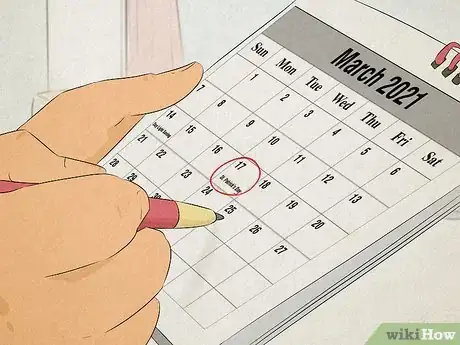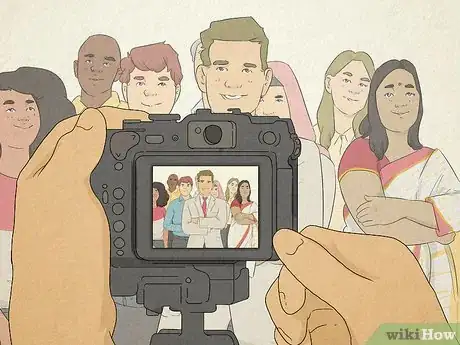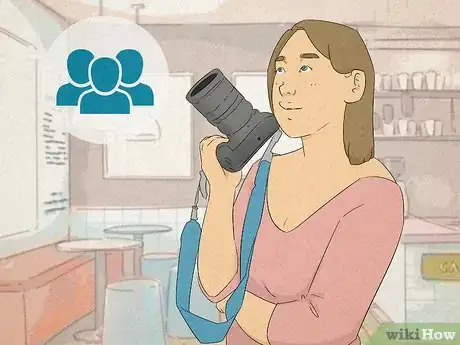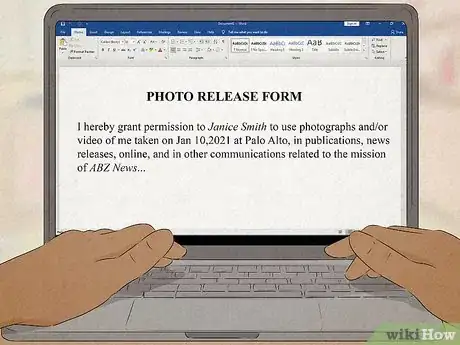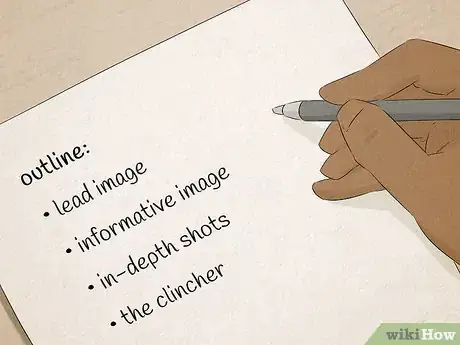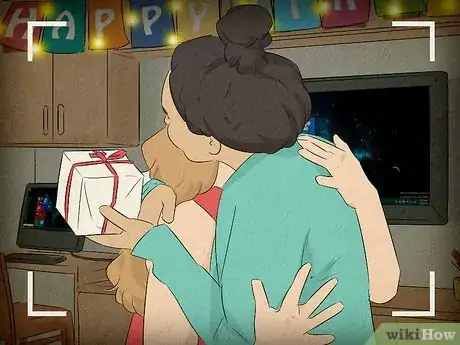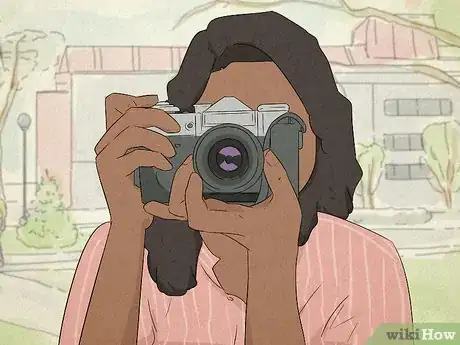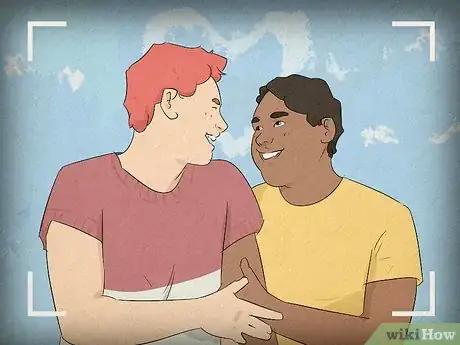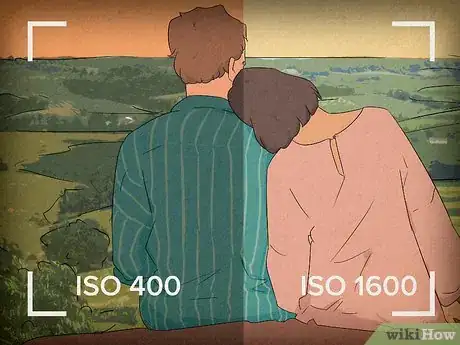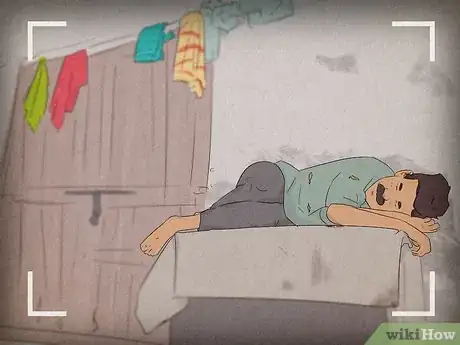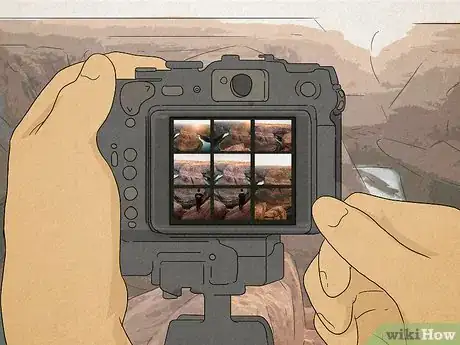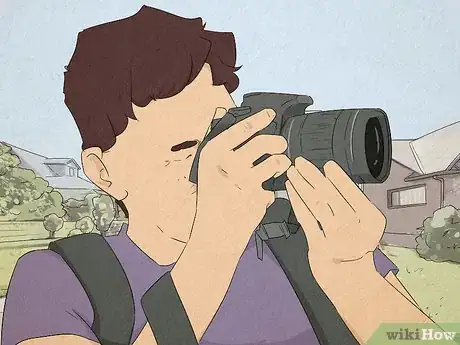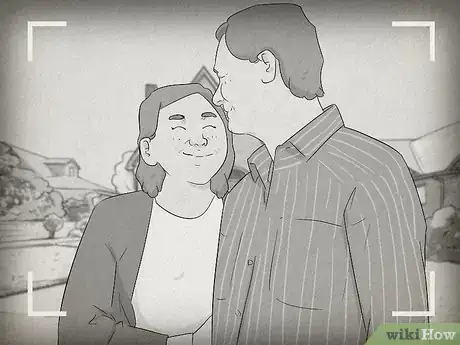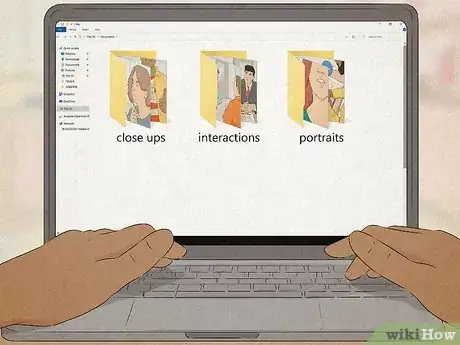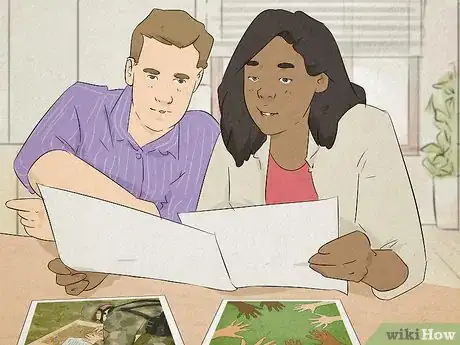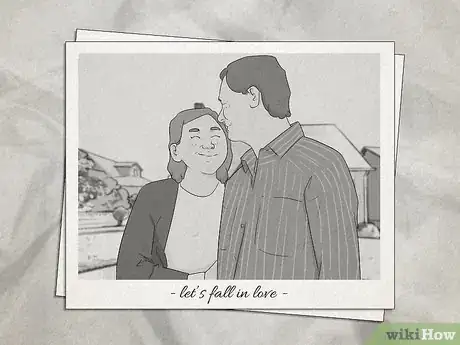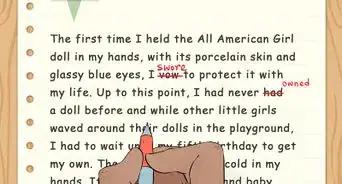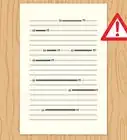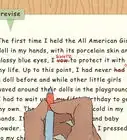This article was co-authored by Heather Gallagher. Heather Gallagher is a Photojournalist & Photographer based in Austin, Texas. She runs her own photography studio named "Heather Gallagher Photography" which was voted Austin's Best Family Photographer and top 3 Birth Photographers in 2017, 2018, and 2019. Heather specializes in family Photojournalism and has over 15 years of experience documenting individuals, families, and businesses all over the world. Her clients include Delta Airlines, Oracle, Texas Monthly, and her work has been featured in The Washington Post and The Austin American Statesman. She is a member of the International Association of Professional Birth Photographers (IAPBP).
There are 11 references cited in this article, which can be found at the bottom of the page.
This article has been viewed 272,384 times.
Photo essays are an increasingly popular medium for journalists, bloggers, and advertisers alike. Whether you’re trying to show the emotional impact of a current news story or share your hobby with friends and family, images can capture your topic in a personal, emotional, and interesting way. Creating a photo essay can be as easy as choosing a topic, getting your images, and organizing the essay.
Things You Should Know
- Reflect long and hard on your topic, considering your audience, current events, and whether to go for a thematic or narrative approach.
- Create an outline, including your focus image, establishing shot, clincher, and other image details.
- When you finally take your photos, remember to take more photos than you think you need and don't be afraid to let the project change as you create it.
Steps
Finding Your Topic
-
1Review current events. These make for great photo essay topics. People are typically at least passingly familiar with the subject matter, and you’ll likely have an audience who cares about your essay. This can be something as simple as holiday shopping or as complex as rising unemployment rates in your area. If you’re interested in finding out more about the subject, chances are others will be too.[1]
-
2Check the local calendar. School activities, fundraisers for charities, and the annual street festival may all make interesting subjects. If you talk about your plans with the organizers prior to the event, you may even have a ready-made place to publish your essay on their website or in the local newspaper.[2]Advertisement
-
3Consider photographing your work or hobbies. These are subjects you’ll already be familiar with, making it easy to plan for a meaningful essay. Take pictures of the place that you work and people you work with. Not only will it help you get to know your coworkers and business better, you may be able to use the essay as a promotional tool for your company. Hobbies are another great topic. Those who share the hobby or who are interested in taking it up will be interested, and you can share your hard work and enjoyment with others.[3]
- Offer a photo essay of your place of business as a training tool.
- Use a photo essay about your business as a sales or social tool by publishing it on your website or social media page.
- Create a how to photo essay to help others learn about your hobby, so they can take it up as well.[4]
-
4Select an interesting subject. Once you have a few ideas, think of how you can photograph and present these to others. Consider which subject will be the easiest to capture and present the most interesting subject matter. Most importantly, choose a subject that inspires you. The chances are if you see something interesting, others will as well.[5]
-
5Understand your audience. Ask yourself, “Who will want to see this photo essay?” Audience is important when it comes to deciding what to shoot. If you have an idea of who will view the essay, you can choose a subject and images that will appeal to them. If you don’t have an audience or place of publication in mind, it’s still important to consider what subjects will appeal to viewers. Many photographers think this means choosing a big subject like poverty or inequality, but many times, the more personal the subject matter, the more appeal it has for others.[6]
-
6Choose a thematic or narrative approach. Both types of essays can be very impactful, but it’s important to consider how best to approach your topic before you begin shooting. This allows you to look for specific shots to meet your needs. Thematic essays look at a big picture idea and show specific examples, and narrative essays tell a story with a beginning, middle, and end. Thematic essays are often used to add emphasis to news stories, but it's important to avoid randomly collecting photos. Each image should add something new. Narratives are often easier to organize, but you may struggle to find just the right photo.
- Thematic subjects are big ideas including things like local gun laws, at-risk youth, or welcoming home soldiers.
- Narrative essays can include a day in the life, how to tutorials, or progression series that show changes over time such as tracking a building project.
- If you have been given a commission or specific publication to work with, you may need to choose a topic that will fit a thematic or narrative approach as outlined by the publication. Make sure you are aware of any publication guidelines in advance.
Organizing Your Shoot
-
1Get permission. If you plan to publish, you’ll need signed waivers from all of your subjects. Even if you don’t plan to publish with a commercial organization but intend to use the images for a personal blog or website, it is polite to ask for permission in advance. If you’re planning to photograph children, always ask their parent’s permission. Make it easy and comfortable for subjects to decline being photographed.
- Consider how difficult it will be to get permission to photograph your subjects. If you already have relationships established, it will be easier. If not, allow for extra time to get permission and/or waivers.
- Schools, daycares, and other places with kids typically have more regulations on who can be photographed and for what purposes. You’ll usually need to get parental approval, in addition to permission from those in charge.[7]
-
2Research your subject. Before you arrive, conduct online searches, read the website of the topic you select, and make phone calls or send emails to find out more. The better you understand your subject before the day of the shoot, the more prepared you’ll be to take images that truly capture the essence of the subject matter.
- Consider doing interviews with people involved prior to the shoot. Ask things like, “What’s the most interesting thing you do during this event?” or “How long have you been involved with this organization?”
- These interviews are also a great opportunity to ask for permission and get waivers.
- If you’re going to visit a job site, charitable event, or other large group activity, ask the person or persons in charge to explain what you’re doing to everyone before you arrive.[8]
-
3Create an outline. Once you have your subject and permission to shoot, take a few moments to sketch out an idea of what photos you’ll need. Most essays need a variety of images to showcase the various aspects of the topic. You’ll want to include at least a signature photo, establishing shot, several detail shots, and a “clincher” photo at the end.[9]
-
4Choose a focus image. Sometimes referred to as signature photos, these should be images that capture the heart of your subject. Think of famous photos like the “Migrant Mother” image by Dorothea Lange, capturing a woman and her children during the Great Depression. This photo has become synonymous with the Great Depression in the US.
-
5Take an establishing shot. This should be a wide-angle image of the overall story. If you’re shooting a day of work at an office, an image of a line of workers entering the building at the beginning of the day could be used as an establishing shot.
-
6Plan out detail images. These shots should include a variety of portraits, close up shots of specific actions, and interactions. For instance, you could include a portrait of your “main character,” for an essay on a day at the office, typing on a computer. You could also include interaction images of the character leading a meeting with others or talking over coffee in the break room. Close ups can include things like images of your subject’s hands as she types or detailed shots of her computer screen.
-
7Include a clincher. This image may not be apparent to you in the beginning, but most photographers say they know it when they see it. It’s an image that wraps up the essay for the viewer. This image should say “the end,” give a call to action, or show the end result of a day in the life or how to sequence.[10]
Capturing Your Images
-
1Check the light. Capture test images to determine what ISO is needed. ISO determines how much light the lens allows through while capturing images, and how quickly the image can be captured. You should use low ISO for brightly lit, slow moving, or still subjects. Increase your ISO to capture images in dim lighting or those that are moving quickly.
- Many new photographers stay away from high ISO shots because they allow more light through producing a “busy” image. However, these images are often easier to edit later as there’s more information to work with.[11]
- If it’s very bright in your location or you’ve set up artificial lighting, a low ISO is likely adequate, For darker areas, you’ll likely need to use a higher ISO.
- Most cameras have a base ISO of about 200. ISO increases by doubling, so the next ISO would be 400, then 800, etc. This essentially doubles the lens sensitivity, allowing more light through and capturing the image more quickly.[12]
- If you need one second to capture an image with a base ISO of 100, you’ll need one eighth of a second to capture with an ISO of 800.[13]
-
2Consider composition. If you’re an experienced photographer, you likely have a variety of photo composition methods that you use regularly. For those who are new to photography, learning a basic technique like the rule of thirds is typically a good place to begin. The rule of thirds is the idea that every photo can be broken down into nine specific areas by creating three vertical sections and crossing them over with three horizontal sections. Then, try to place your main subject in one section with a focal point where the sections cross.
- Even snapping candid shots, which you may need to capture quickly, take a few moments to think about how objects are placed to make the most impact.
- Always think about how the main subject’s surroundings play into the overall image, and try to create different levels and points of interest.
- You can change composition as part of the editing process in some cases, so if you can’t line up the shot just right, don’t let it deter you from capturing the image you want.[14]
-
3Take more photos than you need. If you’re hoping to get ten to fifteen good shots for the essay, you may need to take several hundred photos to get exactly what you want. Capture each image from a variety of angles. Climb up high or take images from the ground to provide a variety of perspectives for your viewers. Zoom in for details and zoom out for overall shots. Shoot each shot several times to make sure you get what you need and give yourself options.[15] .
-
4Let the project evolve. Even though you’ll enter the shoot with an outline, don’t create such a stringent plan that you feel unable to waver from it. If you start the shoot thinking you’re going to capture a series of images that show a day of work in an office, and you end up seeing one specific employee who seems to be doing something interesting, don’t hesitate to follow them instead. Odds are, if you think this is the really interesting part of the shoot, your viewers will think so too.[16]
Organizing the Essay
-
1Exclude photos you don’t need. The first step in organizing your essay is to get rid of unnecessary images. Delete photos that are blurry, unfocused, or overexposed. Take out any images that don’t seem to capture a part of the story you want the essay to tell. You may not necessarily want to delete these photos, as they may come in handy later, or you may change your mind. The goal is to limit the number of images you’re working with to the ones that best tell your story.[17]
-
2Choose a focus image. Find the picture that best summarizes your story. Think about it as the image on the cover of a book. It doesn’t tell the whole story, but it should provide a good idea what the book is about. Your focus or signature image should convey your main goal in creating the essay. Do this in a way that will draw your potential viewers’ eyes and create immediate interest in the story.
- If you’re doing a day in the life photo essay about a frustrated person working in an office, an image of that person struggling to open the front door against the wind might be an apt focus shot.
- If your essay is about the process of building a home, your focus image may be something like a contractor and architect looking at blue prints with the framed up home in the background.
- If your essay is about a family reunion, the focus image may be a funny shot of the whole family making faces, pretending to be fighting, or a serious photo of the family posed together. Capture whatever seems natural for the family.[18]
-
3Categorize your remaining photos. Once you’ve excluded unusable or unnecessary photos and selected your focus image, sort the remaining photos for easy access. Many photographers sort the photos by the type of image (close ups, interactions, portraits, etc.), and others choose to sort their photos based on the organization of the essay. The purpose of this step is to make it easy for you to find specific images, so use whatever categories make sense to you.[19]
-
4Lay out possible designs. Once the photos are sorted, choose an image that specifically fits every part of your essay. You can design your essay in any number of ways. Some of the most common narrative choices include day in the life, how to, and progression (showing how your subject changes over time). For thematic essays, you have many more options. However, most thematic essays begin with a big picture shot, narrow in to show specific examples of the theme, and zoom back out to provide a clincher image that sums up the big idea.
- Regardless of essay type, you’ll need a focus image to grab attention.
- Use an overall shot to give context to your essay. Where is it, when is it happening, who’s involved, what’s going on, and why should someone be interested? The five “W’s” of journalism are a great way to determine what your overall shot should capture.
- Find your final image. This should be something provocative that asks your viewer to think about the topic.
- Between the focus and overall shot and ending image, include a series of images that move the viewer from the lead-in shots to its result. Use images that build in intensity or draw the viewers further into the essay.
-
5Ask for feedback. Once you have the images you like in an order you think tells the story, ask a friend or fellow photographer to take a look. Don’t tell them what the purpose of the essay is or provide them with any of the text. Just let them look at the photos and the order and let them tell you what they’re seeing.
- If the images aren’t telling the story, ask your friends to look at your other photos and ask, “I wanted this image to make this point. You got a different idea. Would any of these images make this point to you more clearly?”
- If the others like the images you’ve chosen, you may still want to ask them to look at your other photos and tell you if they think any of the images you didn’t include should be added in. They may see something you missed.[20]
-
6Add text. Your final step should be adding text. Doing this last helps prevent the tendency to explain the essay in words instead of relying on your photos. There are three main ways to use text within a photo essay. You can add images to support a written essay, you can add captions to images, or you can limit text to a title and a few introductory or concluding words. Whatever choice you make, it’s important that the photos themselves can tell the same story as the written essay.
- If you're commissioned to add photos to an essay, you should make sure images reflect the written word, but also add emotion and context the writing could not capture. For example, an essay on poverty may include an image of a child and parent living on the street could capture more emotional context.
- Captions should only include information the viewer could not derive from the photo itself. For instance, you can include a date, the subject’s name, or a statistic relevant to your subject in the caption.
- If you choose not to have any text or just a title and some introductory and/or closing words, make sure you convey all necessary information succinctly.[21]
Expert Q&A
Did you know you can get expert answers for this article?
Unlock expert answers by supporting wikiHow
-
QuestionWhat should I choose as titles for my images?
 Heather GallagherHeather Gallagher is a Photojournalist & Photographer based in Austin, Texas. She runs her own photography studio named "Heather Gallagher Photography" which was voted Austin's Best Family Photographer and top 3 Birth Photographers in 2017, 2018, and 2019. Heather specializes in family Photojournalism and has over 15 years of experience documenting individuals, families, and businesses all over the world. Her clients include Delta Airlines, Oracle, Texas Monthly, and her work has been featured in The Washington Post and The Austin American Statesman. She is a member of the International Association of Professional Birth Photographers (IAPBP).
Heather GallagherHeather Gallagher is a Photojournalist & Photographer based in Austin, Texas. She runs her own photography studio named "Heather Gallagher Photography" which was voted Austin's Best Family Photographer and top 3 Birth Photographers in 2017, 2018, and 2019. Heather specializes in family Photojournalism and has over 15 years of experience documenting individuals, families, and businesses all over the world. Her clients include Delta Airlines, Oracle, Texas Monthly, and her work has been featured in The Washington Post and The Austin American Statesman. She is a member of the International Association of Professional Birth Photographers (IAPBP).
Professional Photojournalist & Photographer
-
QuestionHow do I figure out my style as a photographer?
 Heather GallagherHeather Gallagher is a Photojournalist & Photographer based in Austin, Texas. She runs her own photography studio named "Heather Gallagher Photography" which was voted Austin's Best Family Photographer and top 3 Birth Photographers in 2017, 2018, and 2019. Heather specializes in family Photojournalism and has over 15 years of experience documenting individuals, families, and businesses all over the world. Her clients include Delta Airlines, Oracle, Texas Monthly, and her work has been featured in The Washington Post and The Austin American Statesman. She is a member of the International Association of Professional Birth Photographers (IAPBP).
Heather GallagherHeather Gallagher is a Photojournalist & Photographer based in Austin, Texas. She runs her own photography studio named "Heather Gallagher Photography" which was voted Austin's Best Family Photographer and top 3 Birth Photographers in 2017, 2018, and 2019. Heather specializes in family Photojournalism and has over 15 years of experience documenting individuals, families, and businesses all over the world. Her clients include Delta Airlines, Oracle, Texas Monthly, and her work has been featured in The Washington Post and The Austin American Statesman. She is a member of the International Association of Professional Birth Photographers (IAPBP).
Professional Photojournalist & Photographer
-
QuestionHow do I pitch a photo essay?
 Heather GallagherHeather Gallagher is a Photojournalist & Photographer based in Austin, Texas. She runs her own photography studio named "Heather Gallagher Photography" which was voted Austin's Best Family Photographer and top 3 Birth Photographers in 2017, 2018, and 2019. Heather specializes in family Photojournalism and has over 15 years of experience documenting individuals, families, and businesses all over the world. Her clients include Delta Airlines, Oracle, Texas Monthly, and her work has been featured in The Washington Post and The Austin American Statesman. She is a member of the International Association of Professional Birth Photographers (IAPBP).
Heather GallagherHeather Gallagher is a Photojournalist & Photographer based in Austin, Texas. She runs her own photography studio named "Heather Gallagher Photography" which was voted Austin's Best Family Photographer and top 3 Birth Photographers in 2017, 2018, and 2019. Heather specializes in family Photojournalism and has over 15 years of experience documenting individuals, families, and businesses all over the world. Her clients include Delta Airlines, Oracle, Texas Monthly, and her work has been featured in The Washington Post and The Austin American Statesman. She is a member of the International Association of Professional Birth Photographers (IAPBP).
Professional Photojournalist & Photographer A lot of this is just going to come down to understanding your audience. Try to look for publications and sites that are actively seeking work that matches the kind of photography you're interested in. Be enthusiastic when you're talking about your work, and do your best to read the room. Keep in mind, it can take effort to get a photo essay published. You may need to give this 10-15 attempts until you're successful!
A lot of this is just going to come down to understanding your audience. Try to look for publications and sites that are actively seeking work that matches the kind of photography you're interested in. Be enthusiastic when you're talking about your work, and do your best to read the room. Keep in mind, it can take effort to get a photo essay published. You may need to give this 10-15 attempts until you're successful!
References
- ↑ http://digital-photography-school.com/5-photo-essay-tips/
- ↑ http://digital-photography-school.com/5-photo-essay-tips/
- ↑ Heather Gallagher. Professional Photojournalist & Photographer. Expert Interview. 8 April 2020.
- ↑ http://improvephotography.com/30816/10-ideas-creative-photo-essays/
- ↑ http://improvephotography.com/30816/10-ideas-creative-photo-essays/
- ↑ http://improvephotography.com/30816/10-ideas-creative-photo-essays/
- ↑ http://www.apogeephoto.com/how-to-create-a-photo-essay/
- ↑ http://www.apogeephoto.com/how-to-create-a-photo-essay/
- ↑ https://petapixel.com/how-to-create-a-photo-essay/
- ↑ http://photo.journalism.cuny.edu/week-5/
- ↑ http://clickitupanotch.com/2010/12/creating-a-photo-essay/
- ↑ Heather Gallagher. Professional Photojournalist & Photographer. Expert Interview. 8 April 2020.
- ↑ https://photographylife.com/what-is-iso-in-photography
- ↑ http://clickitupanotch.com/2010/12/creating-a-photo-essay/
- ↑ https://wiredimpact.com/blog/how-to-make-a-photo-essay-nonprofit/
- ↑ http://digital-photography-school.com/5-tips-for-creating-a-photo-essay-with-a-purpose/
- ↑ http://www.apogeephoto.com/how-to-create-a-photo-essay/
- ↑ https://www.format.com/magazine/resources/photography/how-to-make-photo-essay-examples
- ↑ http://www.apogeephoto.com/how-to-create-a-photo-essay/
- ↑ http://digital-photography-school.com/5-tips-for-creating-a-photo-essay-with-a-purpose/
- ↑ http://improvephotography.com/30816/10-ideas-creative-photo-essays/
About This Article
To make a photo essay, start by selecting a subject that is easy to capture and that inspires you, like a friend or a family pet. Then, decide if you want to present your photo essay as thematic, which shows specific examples of a big idea, or narrative, with a beginning, middle, and end. Next, create an outline of your essay to determine which photos you’ll need, like an establishing shot. Finally, take your photos, select which images you want to use in your essay, and organize them according to your theme before adding text to explain the essay. To learn how to capture the best images, keep scrolling!

